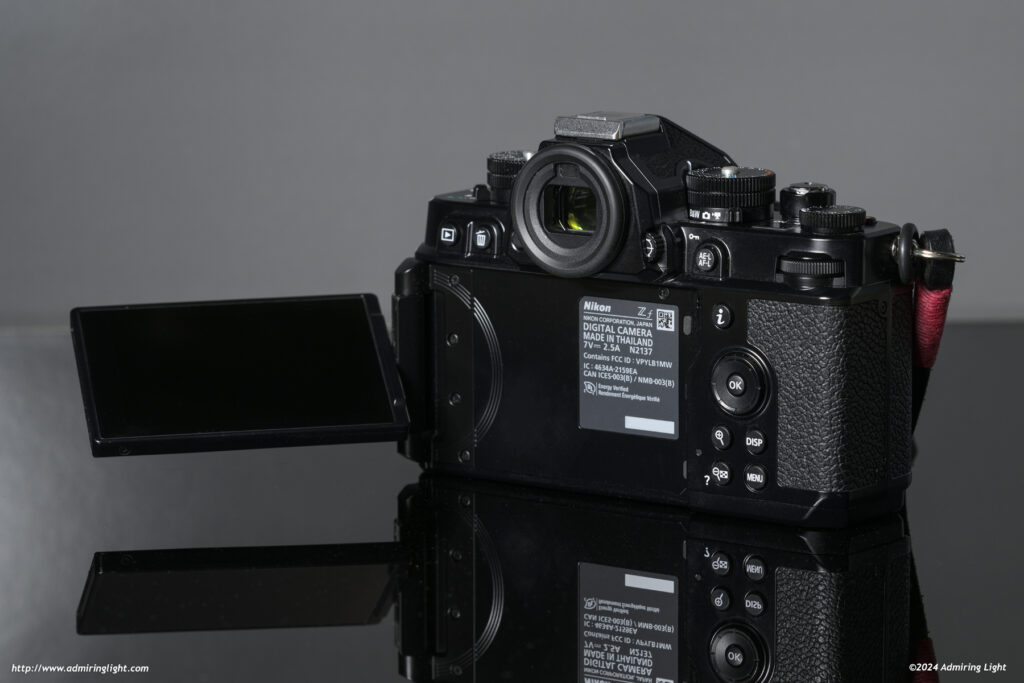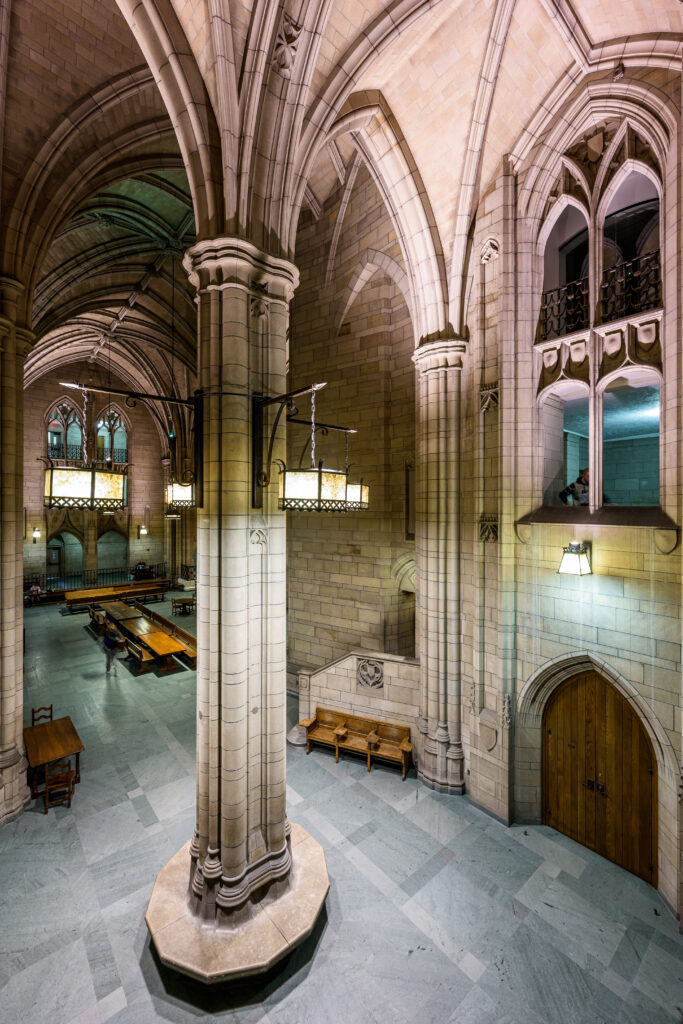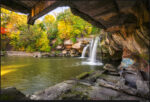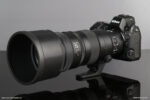Viewfinder and Display
The Zf features what has become the ‘standard’ Nikon EVF, with one minor change, and is largely identical to the viewfinder the the Nikon Z8. This EVF is a 3.6 million dot finder with a very large 0.8x magnification. While many manufacturers have moved to higher resolution 5 or 9 million dot EVFs, including Nikon on its newest Z6 III, one thing I can say is that Nikon’s 3.6M dot viewfinders are better than their specification. The optics themselves are incredibly clear, and the expansive magnification, high panel quality and clarity make the viewfinder in the Zf an absolute pleasure to use.

I actually prefer the viewfinder on the Zf to that on the Canon R5, despite the lower resolution. In one slight cost-cutting measure, however, the Zf’s EVF only refreshes at 60 Hz instead of the 120 Hz offered on the Z8 and Z9. Outside of the refresh, however, it is functionally identical to that of the Z8.
The rear screen on the Zf is a fully-articulated 3.2″ screen with 2.1 million dot resolution. The screen is very clear, bright, contrasty and colorful, and the touch response is quite excellent as well. I personally prefer the dual-axis tilting on the Nikon Z8 to a fully articulated screen, but that comes down to personal preference.
Autofocus and Performance
The Zf is the first prosumer grade body that Nikon has released since they first really figured out their autofocus system with the Z9 and Z8. As such, the camera inherits a lot of the autofocus DNA from those cameras, though it lacks the high-speed stacked sensor that increases readout, and it also lacks a few of the more recent subject detection tweaks that the flagship bodies have gained via firmware update.
In practice, I found the Zf’s 273 focus point AF system to focus much more like the Z8 than it does to earlier bodies like the Z7 II or Z6 II. Focus is quick and accurate, and solid even in low light. Subject tracking also works quite well for people and pets, as well as for limited sports work, but it lacks the dedicated Bird AF mode that has recently been added to the Z8. As such, while it will detect birds, its responsiveness in that department is much weaker than the Z8, which is class leading for bird detection.

Still, for the general shooter, the AF system works very well indeed, and finally puts autofocus capability that is competitive with Sony and Canon in the hands of Nikon shooters without having to spend over $3,000.
As far as performance is concerned, the Zf was not designed as a high-speed body. However, it is still competitive in that area as well. The camera can shoot 11 frames per second with the mechanical shutter when shooting RAW, or 14 frames per second when shooting JPEG. The buffer is reasonably deep as well, allowing for around 185 RAW frames at 11 frames per second. These are great numbers for a ‘retro’ camera, and competitive with other $2,000 cameras in the market.
The Zf is also a responsive camera, gaining the Expeed 7 processor used in the Z8 and Z9, and giving the camera a significant processing edge over the Z7 II and Z6 II, and matching the newer Z6 III. There’s no waiting on the camera after shooting, and everything responds as it should.
In-Body Image Stabilization
Almost every mirrorless camera nowadays features an in-body image stabilization (IBIS) system, and the Zf is no different. What is different is that Nikon has introduced a brand new version of their ‘in camera VR’ as they call it, which pushes the claimed effectiveness all the way to 8 stops. I have almost never gotten anywhere close to the rated effectiveness on an in-body stabilization system, but I can say that the Zf’s IBIS system is excellent, and does show an improvement over the already quite good IBIS found in the Z8.
I found the Zf’s IBIS system to quite regularly get me between 4 and 6 stops of stabilization over what I could get hand held, depending on focal length and whether or not 3-axis or 5-axis stabilization is being used.

The camera uses 5-stop IBIS when it has distance information to use with regards to focus. This is the case with all Nikon Z-mount lenses, but will not be the case with adapted lenses or most manual focus lenses (including the Z-mount Voigtlander lenses). Without distance information, the camera corrects shake in 3 axes. With 3-axis IBIS engaged, 4 stops is about the maximum I can achieve, while with 5-axis IBIS engaged, up to 6 stops is possible. For instance, with my Nikkor Z 24-120mm f/4 S, I can get sharp shots as slow as 1/2 second at 120mm.
Overall, this performance is a little more than a full stop better than what I regularly achieve with the Z8, and around 2 stops better than the Z7 II, making it one of the most effective full-frame IBIS systems I’ve ever used.
Some Key Features
I usually stretch this section into a deep dive of some of the key features, but frankly I’ve grown weary of doing that, so I’m going to simply touch on the highlights.
The Zf has a fairly full array of features, matching or on some ways exceeding bodies that came before it. The Zf inherits all the little goodies of the earlier higher end Z cameras like a built-in intervalometer, auto focus bracketing, starlight view and more. These work very well, and stretch the Zf’s capabilities to make it a very well rounded camera.
It also has support for a large number of manual focus lenses, where you can add focal length and aperture data and quickly switch between them when changing manual lenses. For a retro-styled body, this is good. The Zf works really well with adapted manual focus glass, and I think a lot of people drawn to the retro body will want to use older manual focus lenses on the camera. On the down side, as of July 2024, the Zf still uses the old method of entering non-CPU lenses into the camera. That is, you can only select focal lengths that Nikon made at some point. The same with aperture. The Z8 received a firmware update a couple of months ago that upgraded this feature to allow for adding lens names (for EXIF data), as well as inputting any focal length and aperture into the data. This feature NEEDS to come to the Zf at some point in a firmware update.
Pixel Shift
The Zf is also the first Nikon camera to feature Pixel Shift shooting, where the IBIS system will shift tiny amounts to create very high resolution images. The Zf’s feature can take 4, 8, 16, or 32 images. The 4 and 8 shot modes create true-color images at each pixel (rather than just a Bayer demosaicing), increasing color resolution. The 16 and 32 image stacks will also shift by sub-pixel dimensions increasing total resolution, resulting in final 96 megapixel images. The 8 and 32 image stacks are the same resolution as the 4 and 16 image ones, respectively, but sample each location twice to reduce noise.

Like a lot of pixel shift modes from other manufacturers, the Nikon Zf’s pixel shift mode requires stitching the manufacturer’s software package, NX Studio. As a result, you can’t preview your final image in the field. Also, Nikon’s stitching doesn’t really do any compensation for motion, so ANY movement between frames, whether it be a gentle vibration from the camera or a leaf moving from a breeze, will show odd pixelated artifacts. As a result, it is extremely difficult to create images that really make the pixel shift mode worth it. It’s really only still life and perhaps indoor architecture shooting that can take real advantage of it, and even then, you need to be ultra still so vibrations from the floor don’t ruin the shot.
If you were thinking that macro shooting might be a good use for it, well, think again – it’s exceptionally difficult to get a macro shot to actually stitch properly, because even the finest near imperceptible vibrations from air movement and the floor can add very tiny pixel level movements, which will ruin a stitch, as evidenced by the crops of a close up shot of a lens shown above. I tried twice to get a 32 image stitch to work, and both times, tiny vibrations were enough to ruin the stitch.
That’s a longwinded way to say that while Pixel Shift shooting is here, and it works, it’s impractical enough that very few people will ever use it after the first few tries. The AI upscaler in Photoshop is going to be something that is going to have more real-world benefit than worrying about pixel shift.





Leave a Reply